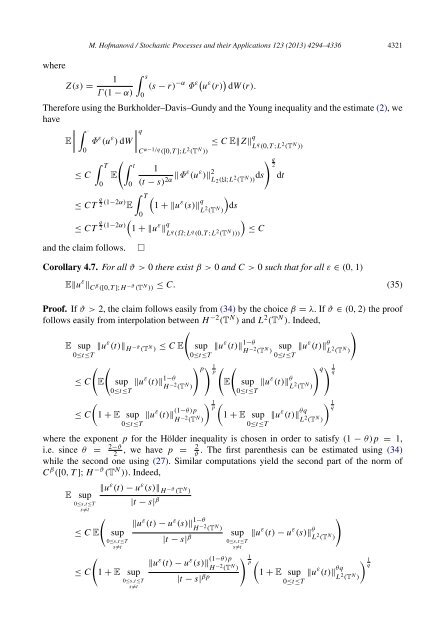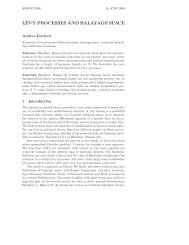Degenerate parabolic stochastic partial differential equations
Degenerate parabolic stochastic partial differential equations
Degenerate parabolic stochastic partial differential equations
You also want an ePaper? Increase the reach of your titles
YUMPU automatically turns print PDFs into web optimized ePapers that Google loves.
where<br />
Z(s) =<br />
M. Hofmanová / Stochastic Processes and their Applications 123 (2013) 4294–4336 4321<br />
1<br />
Γ (1 − α)<br />
s<br />
0<br />
(s − r) −α Φ ε u ε (r) dW (r).<br />
Therefore using the Burkholder–Davis–Gundy and the Young inequality and the estimate (2), we<br />
have<br />
·<br />
E<br />
Φ ε (u ε q<br />
) dW<br />
<br />
≤ C E∥Z∥ q L q (0,T ;L 2 (T N ))<br />
0<br />
≤ C<br />
T<br />
0<br />
0<br />
T<br />
C α−1/q ([0,T ];L 2 (T N ))<br />
q<br />
t<br />
2<br />
1<br />
E<br />
(t − s) 2α ∥Φε (u ε )∥ 2 L 2 (U;L 2 (T N )) ds dt<br />
<br />
<br />
1 + ∥u ε (s)∥ q ds<br />
L 2 (T N )<br />
≤ CT q 2 (1−2α) E<br />
0<br />
≤ CT q (1−2α) <br />
2 1 + ∥u ε ∥ q ≤ C<br />
L q (Ω;L q (0,T ;L 2 (T N )))<br />
and the claim follows.<br />
□<br />
Corollary 4.7. For all ϑ > 0 there exist β > 0 and C > 0 such that for all ε ∈ (0, 1)<br />
E∥u ε ∥ C β ([0,T ];H −ϑ (T N )) ≤ C. (35)<br />
Proof. If ϑ > 2, the claim follows easily from (34) by the choice β = λ. If ϑ ∈ (0, 2) the proof<br />
follows easily from interpolation between H −2 (T N ) and L 2 (T N ). Indeed,<br />
<br />
<br />
E sup ∥u ε (t)∥ H −ϑ (T N ) ≤ C E sup ∥u ε (t)∥ 1−θ sup ∥u ε (t)∥ θ H<br />
0≤t≤T<br />
0≤t≤T<br />
−2 (T N )<br />
L<br />
0≤t≤T<br />
2 (T N )<br />
<br />
p 1 <br />
<br />
p q 1<br />
q<br />
≤ C E sup ∥u ε (t)∥ 1−θ<br />
H<br />
0≤t≤T<br />
−2 (T N )<br />
<br />
≤ C 1 + E sup ∥u ε (t)∥ (1−θ)p<br />
H<br />
0≤t≤T<br />
−2 (T N )<br />
1<br />
p<br />
<br />
E<br />
sup ∥u ε (t)∥ θ L<br />
0≤t≤T<br />
2 (T N )<br />
1 + E sup ∥u ε (t)∥ θq<br />
L<br />
0≤t≤T<br />
2 (T N )<br />
where the exponent p for the Hölder inequality is chosen in order to satisfy (1 − θ)p = 1,<br />
i.e. since θ = 2−ϑ<br />
2 , we have p = ϑ 2 . The first parenthesis can be estimated using (34)<br />
while the second one using (27). Similar computations yield the second part of the norm of<br />
C β ([0, T ]; H −ϑ (T N )). Indeed,<br />
E<br />
sup<br />
0≤s,t≤T<br />
s≠t<br />
≤ C E<br />
≤ C<br />
<br />
∥u ε (t) − u ε (s)∥ H −ϑ (T N )<br />
|t − s| β<br />
<br />
sup<br />
0≤s,t≤T<br />
s≠t<br />
1 + E sup<br />
0≤s,t≤T<br />
s≠t<br />
∥u ε (t) − u ε (s)∥ 1−θ<br />
<br />
H −2 (T N )<br />
|t − s| β sup ∥u ε (t) − u ε (s)∥ θ L 2 (T N )<br />
0≤s,t≤T<br />
s≠t<br />
∥u ε (t) − u ε (s)∥ (1−θ)p 1<br />
p <br />
1<br />
H −2 (T N )<br />
|t − s| βp 1 + E sup ∥u ε (t)∥ θq q<br />
L<br />
0≤t≤T<br />
2 (T N )<br />
1<br />
q



